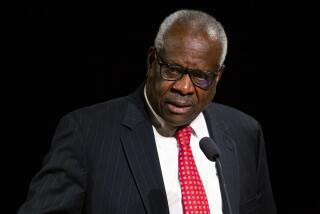Watch out for migratory birds, court tells FCC
When considering new communications towers, a federal court ruled Tuesday, officials need to consider whether they pose safety risks -- to birds.
The Federal Communications Commission must study the effect of rapidly sprouting communications towers on migratory birds and give the public a chance to request environmental reviews on new tower applications, the U.S. Court of Appeals for the D.C. Circuit said.
The U.S. Fish and Wildlife Service says that millions of warblers, thrushes and other birds die each year because continuously burning lights atop those towers can disorient them in bad weather.
The 2-1 decision affects only towers along the Gulf Coast from Texas to Florida, a major route for migrating birds.
But environmentalists hope the ruling will spur the FCC to approve proposed rules that would mandate white strobe lights on new towers nationwide. Studies have shown that those lights aren’t as disorienting to birds and could cut deaths by 70%.
“It would be extremely beneficial if the FCC took this as a sign they need to act and do it in a national way,” said Darin Schroeder, executive director of conservation advocacy at the American Bird Conservancy, which sued the FCC over the issue. “We simply don’t want to see species that people have seen for generations out their back windows . . . disappear.”
An FCC spokeswoman declined to comment on the decision.
Communications towers taller than 200 feet require lights so that airplane pilots can see them at night. But during bad weather migratory birds can mistake the lights for the stars they use to navigate. The disoriented birds circle the towers endlessly. Some crash into the towers, their guy wires or other birds. Others fall to the ground from exhaustion.
In 2002, the American Bird Conservancy and the Forest Conservation Council asked the FCC to study the environmental effect of the Gulf Coast towers on birds, consult with the Fish and Wildlife Service on the issue and take steps to reduce the deaths. The groups also asked that the FCC give advance notice of tower applications so that they could be challenged.
The FCC dismissed the requests.
The court ruled that the FCC was justified in not taking steps to reduce bird deaths specifically on the Gulf Coast because it had already started studying the issue nationwide. In November 2006, FCC staff proposed requiring more bird-friendly tower lights. The agency is still considering that proposal.
But the court found that the FCC had erred when it decided it didn’t have to do an environmental assessment or consult with the Fish and Wildlife Service. It sent those issues back to the FCC on Tuesday.
It also said the FCC must determine how to give the public notice of new tower applications. The FCC now publicizes applications only after they have been approved.
“We think it is a very significant ruling because it requires the Federal Communications Commission to carefully consider the environmental impact of these communications towers on bird population, and it ensures the public will have timely notice of applications for tower permits,” said Stephen Roady, an attorney for Earthjustice, a public interest law firm that argued the case.
jim.puzzanghera @latimes.com
More to Read
Start your day right
Sign up for Essential California for news, features and recommendations from the L.A. Times and beyond in your inbox six days a week.
You may occasionally receive promotional content from the Los Angeles Times.







